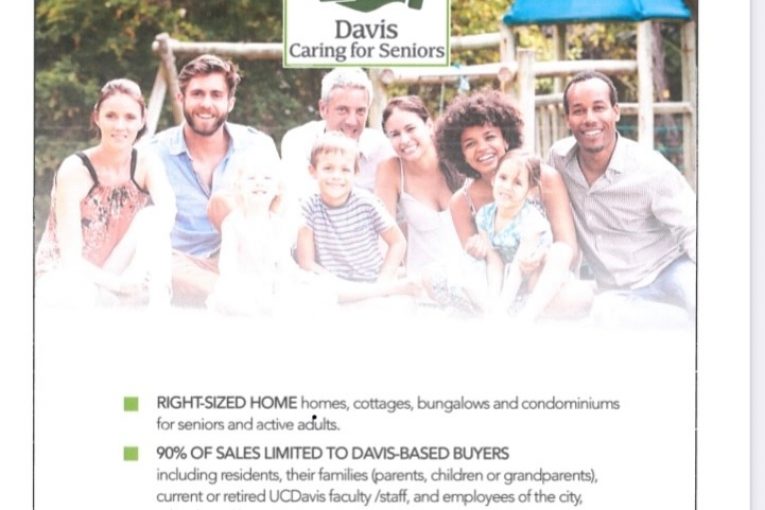

By Eric Gelber
Below is the text of my letter submitted to the Davis Planning Commission for its April 14th meeting expressing issues and concerns with the Bretton Woods Davis-Connected Buyers Program.
Commissioners:
I write to express concerns with the Davis-Connected Buyers Program (DCBP), which is scheduled to be presented at the Planning Commission’s April 14, 2021 meeting. I am disappointed that this agenda item is an informational update only rather than an action item. That suggests that the City Council is not interested in further commission input or recommendations on the DCBP and that its approval by the Council as submitted by the developer is a fait accompli.
I am now retired but have nearly four decades experience with state and federal fair housing laws. I was an attorney with Disability Rights California, California’s designated non-profit disability protection and advocacy organization, for 26 years and subsequently held positions as Chief Consultant for the Assembly Human Services Committee and as legislative director for the California Department of Developmental Services. I am also a former member of the Davis Social Services Commission.
Provisions of the DCBP do not make sense and the program will almost certainly not achieve its purported purpose. Most importantly, as has been alleged—including in a lawsuit challenging the DCBP that was subsequently dismissed without prejudice on procedural grounds—the DCBP is likely to perpetuate, and possibly exacerbate, existing racial disparities in Davis as compared to the  region.
region.
The stated purpose of the DCBP is purportedly to meet a local housing need by increasing the City’s housing stock for local seniors. The DCBP would supposedly meet that need by requiring 90% of the market rate homes in Bretton Woods be sold to buyers with Davis connections. The Bretton Woods Davis Connection Form (Staff Report, Attachment 1, p. 9) delineates a pre-existing connection to Davis as including the following:
- Current or former City of Davis resident, or living within the DJUSD boundary.
- Mother/father/grandmother/grandfather or child of current or former Davis resident.
- Current or incoming employee of UC Davis, City of Davis, DJUSD, Davis-based business.
- Retired or former employee of UC Davis, City of Davis, DJUSD, Davis-based business.
- Graduated or attended UC Davis, Davis elementary or secondary school.
I hope commissioners will ask the developer, for example, how prioritizing sales to seniors who are former Davis residents, but who may not have set foot in the city for decades, will meet the housing needs of seniors currently living in Davis. Similarly, how will selling to seniors who may have attended grade school in Davis as a child, or attended UCD decades ago, but have not lived in Davis since then, meet the housing needs of seniors now living in Davis? The same type of questions should be asked with respect to seniors who are former employees of Davis-based businesses, UCD, or DJUSD, close relatives of former Davis residents, etc.
The DCBP excludes seniors who are deemed non-connected and are treated as unwelcome “outsiders,” including, for example, seniors who may not have lived in Davis or worked for a Davis-based business but who live outside the city limits and have provided goods or services to Davis businesses or residents for decades. Non-connected seniors also include those from outside the city limits who regularly patronize Davis-based businesses.
The developer has asserted that purchasers of Bretton Woods homes will consist largely of seniors who are Davis homeowners seeking to downsize, making their larger homes available to a new generation. To the extent those larger homes are purchased by out-of-area, cash-rich homeowners (e.g., from the Bay Area), however, there would be little or no net increase in housing available to Davis residents in need of housing.
In sum, the DCBP eligibility requirements are arbitrary, irrational, and exclusionary, and will not achieve the asserted purpose.
The developer also claims that the DCBP would not perpetuate discriminatory housing practices of the past because “any member of a protected class is not required to demonstrate a Davis connection when purchasing a home in Bretton Woods ….” They further clarify, claiming that “… anyone identifying with a race, color, national origin, religion, gender, disability, familial status, marital status, sexual orientation, or gender identity that is protected by State or Federal Fair Housing laws will not need to complete the form identifying their connection to Davis.” (Attachment 1, p. 2.) This declaration shows a complete lack of understanding of fair housing laws.
Fair housing laws do not classify races, colors, national origins, religions, genders, disabilities, marital statuses, sexual orientations, or genders as protected vs. non-protected. Fair housing laws prohibit discrimination based on those characteristics regardless of one’s race, color, religion, gender, etc.; everyone is protected against discrimination based on those categories.*
Based on the DCBP as defined, therefore, everyone would be exempt from the Davis connection requirement. Thus, the checkbox on the Davis Connection Form labeled “Exempt Protected Class” makes no sense because everyone is protected against discrimination in housing based on race, religion, gender, etc. regardless of what race, religion, gender, etc. they are.
In addition to being arbitrary and irrational, and despite the developer’s claim to the contrary, the DCBP would, in fact, likely perpetuate disparities in the City’s racial demographics. Davis’ population, particularly the senior population, is less racially diverse than the County, the broader region, and the state as a whole. Because of Davis’ historical relative lack of diversity, seniors, in particular, who have prior connections to Davis or are related to Davis residents would be expected to be less diverse than the general (non-connected) population. A policy that excludes non-connected home buyers from purchasing 90% of the individual homes in Bretton Woods is highly likely, therefore, to perpetuate (or even exacerbate) the city’s historical lack of diversity.
During the Measure L campaign, the Bretton Woods developer employed strategies aimed at garnering votes. Some involved outright misrepresentation. As an example of the latter, I would refer you to the campaign flyer on page 11 of the Staff Report (Attachment 1). The photo depicts three young couples with young children—the very families that Bretton Woods prohibits from purchasing any more than 20% of the available homes. No seniors are depicted. This campaign flyer misrepresents the proposed development and was clearly intended to attract votes from non-seniors, including families with children.
The ill-advised DCBP was an additional cynical effort to garner votes during the Measure L campaign. It is being maintained now to save face and the developer’s reputation, not to address local housing needs.
I ask that the City Council give further consideration to amending the Bretton Woods Development Agreement to remove the senseless, unjustified, and potentially counterproductive Davis-Connected Buyers Program.
Sincerely,
Eric Gelber
Davis
cc: Davis City Council Members
* “Familial status” is an exception. State and federal fair housing laws permit discrimination against families with children in qualified senior housing communities. Bretton Woods is an example of such legally authorized housing discrimination.
Support our work – to become a sustaining at $5 – $10- $25 per month hit the link:






The more attention is given to this, the more embarrassing (and downright amusing) it becomes.
You’d think they’d just withdraw the program, take their lumps (regarding how it is perceived), and move on.
But noooo. 🙂
I appreciate Mr. Gelber’s thoughtful analysis of the Davis Connect Buyers Program. And I also appreciate the op ed in the Davis Enterprise on April 11th written by Goldstene and Lee. Both articles get at what is making many of us (voting citizens) irritable about Bretton Woods, and well most developments. A project is presented with a spin that gets the voters behind it and then the game changes.
I would like to offer one more piece to the equation to consider. In a community that is majority white being used as a pool for selection and priority for housing. You might ask yourself if that is the definition of redlining?
In the book The Color of Law, Richard Rothstein, offered the description of redlining that reads like this “The government’s efforts were primarily designed to provide housing to white, middle-class, lower-middle-class families while African-Americans and other people of color were left out of the new suburban communities …”.
If the group you are selection from is white and that is the preference group for housing in Davis it sure sounds like redlining to me. I think during review by City Council, Planning and Social Services we need to ask more of our builders and developers when setting the stage for new projects to be voted on and ultimately built.
-Georgina Valencia
The Bretton Woods Davis Connection Form delineates a pre-existing connection to Davis as including the following:
• Current or former City of Davis resident, or living within the DJUSD boundary.
• Mother/father/grandmother/grandfather or child of current or former Davis resident.
• Current or incoming employee of UC Davis, City of Davis, DJUSD, Davis-based business.
• Retired or former employee of UC Davis, City of Davis, DJUSD, Davis-based business.
• Graduated or attended UC Davis, Davis elementary or secondary school.
• Purchased at least one drink at Wunderbar, Froggies or the Graduate while passing through Davis. (receipt not required)
I would add, “and send the measure back to the voters for approval“. So I can vote against it again. This is Davis at its worst. We need dense housing we all say, and we vote for a not-that-dense place on the outskirts ‘for grandma’; and we say we want non-discriminatory housing and more diversity, and vote for something that is exclusionary to association to the elite Davis root stock. Seriously – have you all gone stark-raving mad?!??!!!
An incredibly well-reasoned and logical article.
The senior population is highly unlikely to become more diverse under ANY circumstances. Due to the wealth disparity that already exists in this country, non-white seniors are unlikely to have the assets required to buy into the Davis housing market. The original DCBP is designed (in an admittedly flawed way) to open up the remaining housing market to younger non-white families that may have sufficient future income to buy into housing market. The fact is that there are not bright, high walls between each segment of the housing market–consumers move between apartments, duplexes, small SF, large SF–and what we can try to do is tip the overall market so that more consumers move into the segments we prefer and open up the lower cost segments for those who are less able to afford housing. We can’t build our way out of this by solely focusing on the tiny amount of Affordable Housing that we can build–it’s going to take a much broader effort on our part to end the segregation that we have in our community.